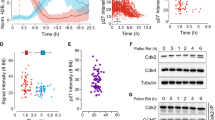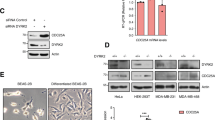Abstract
The cyclin-dependent kinase inhibitor p27Kip1 is known as a negative regulator of cell-cycle progression and as a tumour suppressor1. Cdk2 is the main target of p27 (refs 2, 3) and therefore we hypothesized that loss of Cdk2 activity should modify the p27−/− mouse phenotype4,5,6. Here, we show that although p27−/− Cdk2−/− mice developed ovary tumours and tumours in the anterior lobe of the pituitary, we failed to detect any functional complementation in p27−/− Cdk2−/− double-knockout mice, indicating a parallel pathway regulated by p27. We observed elevated levels of S phase and mitosis in tissues of p27−/− Cdk2−/− mice concomitantly with elevated Cdc2 activity in p27−/− Cdk2−/− extracts. p27 binds to Cdc2, cyclin B1, cyclin A2, or suc1 complexes in wild-type and Cdk2−/− extracts. In addition, cyclin E binds to and activates Cdc2. Our in vivo results provide strong evidence that Cdc2 may compensate the loss of Cdk2 function.
This is a preview of subscription content, access via your institution
Access options
Subscribe to this journal
Receive 12 print issues and online access
$209.00 per year
only $17.42 per issue
Buy this article
- Purchase on Springer Link
- Instant access to full article PDF
Prices may be subject to local taxes which are calculated during checkout





Similar content being viewed by others
References
Sherr, C. J. & Roberts, J. M. CDK inhibitors: positive and negative regulators of G1-phase progression. Genes Dev. 13, 1501–1512 (1999).
Polyak, K. et al. p27Kip1, a cyclin-cdk inhibitor, links transforming growth factor-β and contact inhibition to cell cycle arrest. Genes Dev. 8, 9–22 (1994).
Polyak, K. et al. Cloning of p27Kip1, a cyclin-dependent kinase inhibitor and a potential mediator of extracellular antimitogenic signals. Cell 78, 59–66 (1994).
Fero, M. L. et al. A syndrome of multiorgan hyperplasia with features of gigantism, tumorigenesis, and female sterility in p27Kip1-deficient mice. Cell 85, 733–744 (1996).
Kiyokawa, H. et al. Enhanced growth of mice lacking the cyclin-dependent kinase inhibitor function of p27Kip1 . Cell 85, 721–732 (1996).
Nakayama, K. et al. Mice lacking p27Kip1 display increased body size, multiple organ hyperplasia, retinal dysplasia, and pituitary tumors. Cell 85, 707–720 (1996).
Tsutsui, T. et al. Targeted disruption of CDK4 delays cell cycle entry with enhanced p27Kip1 activity. Mol. Cell. Biol. 19, 7011–7019 (1999).
Berthet, C., Aleem, E., Coppola, V., Tessarollo, L. & Kaldis, P. Cdk2 knockout mice are viable. Curr. Biol. 13, 1775–1785 (2003).
Ortega, S. et al. Cyclin-dependent kinase 2 is essential for meiosis but not for mitotic cell division in mice. Nature Genet. 35, 25–31 (2003).
Geng, Y. et al. Cyclin E ablation in the mouse. Cell 114, 431–443 (2003).
Parisi, T. et al. Cyclins E1 and E2 are required for endoreplication in placental trophoblast giant cells. EMBO J. 22, 4794–4803 (2003).
Sotillo, R. et al. Cooperation between Cdk4 and p27kip1 in tumor development: a preclinical model to evaluate cell cycle inhibitors with therapeutic activity. Cancer Res. 65, 3846–3852 (2005).
Brenner, R. M. et al. Immunocytochemical assessment of mitotic activity with an antibody to phosphorylated histone H3 in the macaque and human endometrium. Hum. Reprod. 18, 1185–1193 (2003).
Koff, A. et al. Human cyclin E, a new cyclin that interacts with two members of the CDC2 gene family. Cell 66, 1217–1228 (1991).
Dai, Y., Dent, P. & Grant, S. Induction of apoptosis in human leukemia cells by the CDK1 inhibitor CGP74514A. Cell Cycle 1, 143–152 (2002).
Russo, A. A., Jeffrey, P. D., Patten, A. K., Massagué, J. & Pavletich, N. P. Crystal structure of the p27Kip1 cyclin-dependent kinase inhibitor bound to the cyclin A-Cdk2 complex. Nature 382, 325–331 (1996).
Aleem, E., Berthet, C. & Kaldis, P. Cdk2 as a master of S phase entry: fact or fake? Cell Cycle 3, 35–37 (2004).
Matsumoto, Y. & Maller, J. L. A centrosomal localization signal in cyclin E required for Cdk2-independent S phase entry. Science 306, 885–888 (2004).
Ayscough, K., Hayles, J., MacNeill, S. A. & Nurse, P. Cold-sensitive mutants of p34cdc2 that suppress a mitotic catastrophe phenotype in fission yeast. Mol. Gen. Genet. 232, 344–350 (1992).
Hoang, A. T., Cohen, K. J., Barrett, J. F., Bergstrom, D. A. & Dang, C. V. Participation of cyclin A in Myc-induced apoptosis. Proc. Natl Acad. Sci. USA 91, 6875–6879 (1994).
Truett, G. E. et al. Preparation of PCR-quality mouse genomic DNA with hot sodium hydroxide and tris (HotSHOT). Biotechniques 29, 52–54 (2000).
Harborth, J., Elbashir, S. M., Bechert, K., Tuschl, T. & Weber, K. Identification of essential genes in cultured mammalian cells using small interfering RNAs. J. Cell Sci. 114, 4557–4565 (2001).
Ahmed, S. A., Gogal, R. M. Jr & Walsh, J. E. A new rapid and simple non-radioactive assay to monitor and determine the proliferation of lymphocytes: an alternative to [3H]-thymidine incorporation assay. J. Immunol. Methods 170, 211–224 (1994).
Matsushime, H. et al. D-type cyclin-dependent kinase activity in mammalian cells. Mol. Cell. Biol. 14, 2066–2076 (1994).
Acknowledgements
The authors thank N. Jenkins and N. Copeland for advice, suggestions, reagents and support. We are thankful to C. Berthet for reagents, discussion and comments on the manuscript. We also thank M. Fortini and I. Daar for providing equipment and reagents; K. Stull and M. Beth Hilton for animal care; K. Rogers, M. Anver and the technicians of the Pathology/Histotechnology Laboratory for superb analysis of mouse pathology; and the Kaldis laboratory for support. We thank N. Copeland and S. Sharan for comments on the manuscript. This work was supported by the National Cancer Institute.
Author information
Authors and Affiliations
Ethics declarations
Competing interests
The authors declare no competing financial interests.
Supplementary information
Supplementary Information
Supplementary figures S1, S2 and S3 (PDF 817 kb)
Rights and permissions
About this article
Cite this article
Aleem, E., Kiyokawa, H. & Kaldis, P. Cdc2–cyclin E complexes regulate the G1/S phase transition. Nat Cell Biol 7, 831–836 (2005). https://doi.org/10.1038/ncb1284
Received:
Accepted:
Published:
Issue Date:
DOI: https://doi.org/10.1038/ncb1284
This article is cited by
-
Stomatin-like protein 2 promotes cell proliferation and survival under 5-Fluorouracil stress in hepatocellular carcinoma
Molecular Biology Reports (2024)
-
DNA Methylation and Histone Modification Are the Possible Regulators of Preimplantation Blastocyst Activation in Mice
Reproductive Sciences (2023)
-
Objective to identify and verify the regulatory mechanism of DTNBP1 as a prognostic marker for hepatocellular carcinoma
Scientific Reports (2022)
-
CDK4/6 initiates Rb inactivation and CDK2 activity coordinates cell-cycle commitment and G1/S transition
Scientific Reports (2022)
-
CDC7-independent G1/S transition revealed by targeted protein degradation
Nature (2022)



